Getting Started
Growing your own chillies means you can enjoy a huge array of colours, shapes, flavours and levels of heat – a much wider range than you could ever buy in supermarkets.
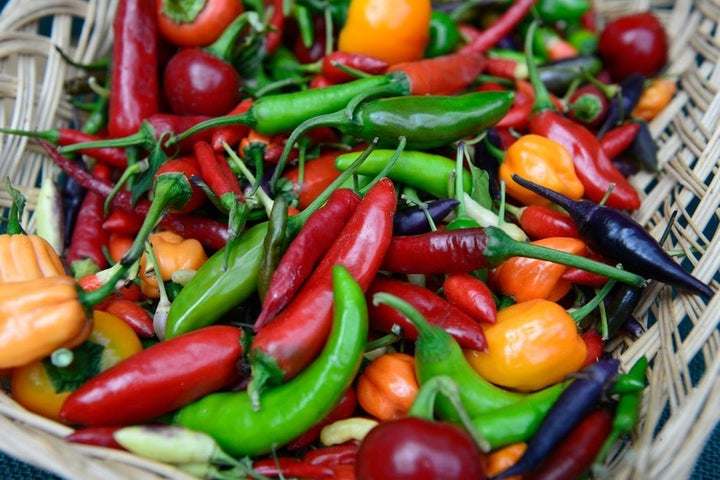
Chillies (Capsicum) are tender plants that need heat, and lots of sunshine to fruit well. Closely related to sweet peppers, they make attractive plants with their colourful, glossy fruits. They grow well in containers and take up little space, with compact varieties reaching only 20–30cm (8–12in) tall. This makes it easy to grow several different varieties, even when space is tight. For the best crop, grow them in a greenhouse, polytunnel or sunny conservatory. They should also be happy in a sheltered, sun-baked spot outdoors – ideally beside a south-facing wall or on a sunny patio or balcony. They generally like similar growing conditions to tomatoes, so are ideal companions.
Month by Month
Sow
Plant
Harvest
Choosing What To Grow
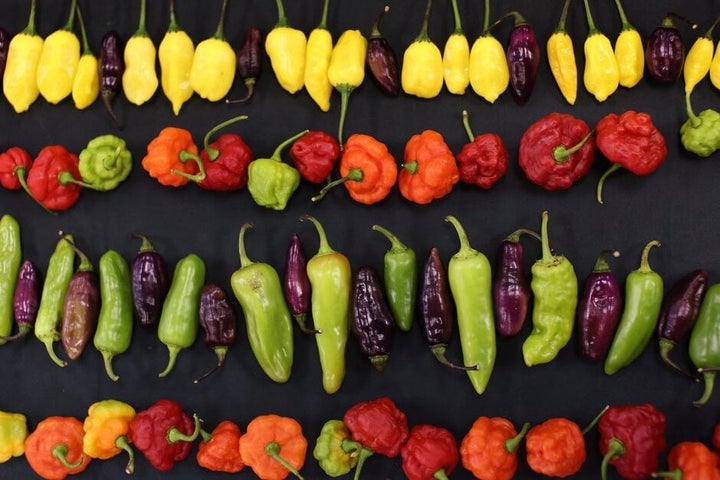
There are hundreds of varieties of chillies to choose from, offering fruits of various colours, shapes and sizes, ranging from mild to unbearably hot. Chilli heat is measured in Scoville Heat Units (SHU), with milder varieties such as ‘Anaheim’ rated at 500–2,500 SHU, ‘Jalapeno’ at 2,500–8,000 SHU, ‘Scotch Bonnet’ at 100,000–350,00 SHU and ‘Carolina Reaper’, one of the world’s hottest chillies, at 2.2 million SHU! Heat is not just dependent on the variety though, it can also vary according to the growing conditions and stage of ripeness.
Chilli plants vary in size from as little as 20cm (8in) tall and wide (ideal for a windowsill), up to 60cm (2ft) or more, depending on the variety, so select to suit your growing space. Also look for varieties with an RHS Award of Garden Merit (AGM), which shows they performed particularly well in our trials – check out our list of AGM fruit and veg (135kB pdf) and our Recommended Varieties below. You’ll also see lots of colourful chillies growing in the veg plots at the RHS gardens over the summer months, so do visit to compare varieties and pick up growing tips.
What and where to buy
Chilli seeds are widely available in garden centres and from online seed suppliers. There are also many specialist chilli seed retailers, who offer the widest choice of varieties.
Many of these suppliers also sell young plants in spring and early summer. These are handy if you don’t have time to sow seeds or don’t have a suitably warm, bright place indoors to raise good plants. Another option is to buy grafted plants, which are more vigorous so should produce larger crops, and are especially useful if growing conditions are a little cool. They can be ordered from online suppliers for delivery from mid-April. Many retailers also sell chilli plants already in fruit over the summer months.
Recommended Varieties

'Apache' AGM
F1 hybrid, up to 60cm (2ft) tall. Abundant crop of hot, fiery fruits – 80,000 units on Scoville Scale.

'Fuego' AGM
Cayenne type with long tapering fruits. More cold tolerant than most. Hot fruits: 30,000-50,000 SHU.

'Hot Thai' AGM
Up to 200 small, hot chillies per plant – 50,000–70,000 SHU. Plants about 70cm (20in) tall.
Sowing
Sow seeds indoors from late winter to mid-spring – chillies generally need a long growing season, and an early start will give you an earlier and longer harvest. Chilli seeds need warmth to germinate – around 21°C (70°F) – so it’s best to use a , although a warm windowsill should be fine too.
As soon as your appear, take them out of the and keep them at 16–18°C (60–64°F) in bright light, watering to keep the evenly moist. When they are 2–3cm (1in) tall, move each one into its own module or small pot of peat-free multi-purpose compost. Then, once roots begin to show through the drainage holes, move them into larger 13cm (5in) pots.
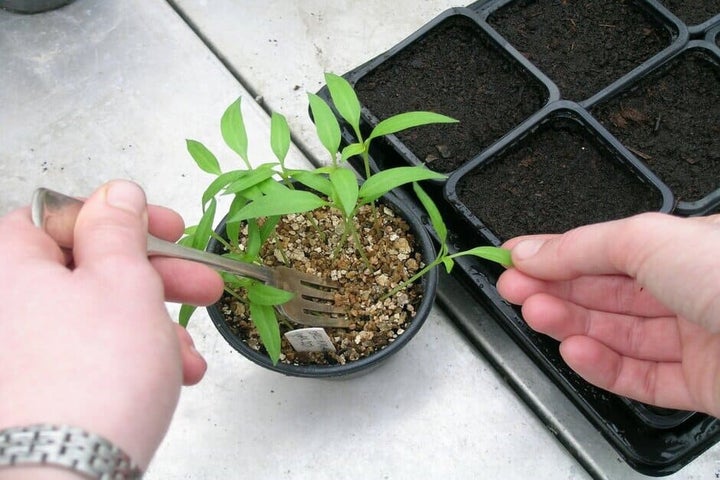
Planting
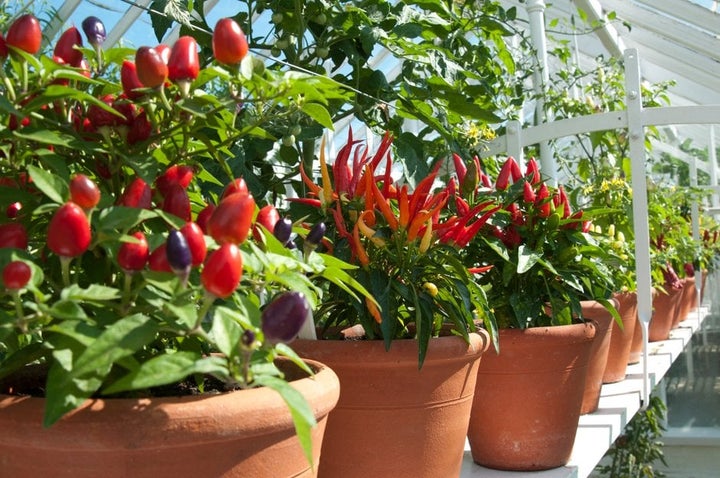
Young chilli plants, either grown from seed or newly bought, must be kept indoors in the warmth, usually until at least late May. Then you can either plant them in their final container in a greenhouse or similar protected location, or get them ready for life outdoors.
Chilli plants grow and crop best in a greenhouse, polytunnel, conservatory or coldframe. Compact varieties can also be grown on a sunny windowsill indoors. In mild locations, you can consider planting them outside too, once night-time temperatures are reliably at least 12°C (54°F), usually by late May or early June. Take care to harden them off for two to three weeks, to acclimatise them to outdoor conditions. Chillies need your warmest, sunniest spot to produce a good crop outdoors, ideally on a sunny patio or by a south-facing wall. Plant them in their new location at the same level they were growing previously and add canes to support taller varieties.
To grow in containers, plant one in a 22cm (9in) pot filled with peat-free multi-purpose , or plant three in a standard growing bag.
To grow in the ground, choose a spot with well-drained, fertile, moisture-retentive soil. If your soil is poor or very heavy, dig in a few bucketfuls of organic matter, such as garden compost or well-rotted manure, before planting. Alternatively, if you practise no-dig, mulch the soil ahead of planting directly into the . Warm the soil with cloches for a couple of weeks before planting so plants get off to a strong start. Space chilli plants 38–45cm (15–18in) apart, depending on the variety. Dwarf varieties can be spaced 30cm (1ft) apart. Cover young plants with cloches to provide wind and cold protection, preferably until the end of June.
Plant Care
Temperature and humidity
Chilli plants can usually cope with a minimum night temperature of about 12°C (54°F), but will grow better if kept above 15°C (59°F). However, temperatures over 30°C (86°F) can reduce fruiting, so in hot spells keep the greenhouse well ventilated and put up shading.
Chillies prefer a humid atmosphere, so raise the air’s moisture content in warm weather by the greenhouse daily – pour a full watering can over the floor, then leave it to evaporate.
Watering
Chillies need a steady supply of moisture to grow and crop well, so water as needed, aiming to keep the soil or potting evenly moist. Flower may fall off if plants get too dry. Plants in containers can dry out very quickly in summer, so check the compost regularly and be prepared to water daily in hot, dry weather.
If you are growing your chilli plants in the ground, the soil with a thick layer of organic matter to help reduce moisture loss.
Feeding
Feed chilli plants in containers with an organic, high potassium, liquid fertiliser weekly, as soon as flowering starts. Plants growing in enriched soil may not need regular feeding, but doing so can help to boost yield.
Overwintering
Chilli plants can be overwintered in a heated location, rather than started afresh each year. This will give you a head start on your chilli production the following summer. Plants should be pruned back to a manageable size, then kept in a warm, bright place, such as an indoor windowsill or conservatory, and watered sparingly. See our video guide below for full details:
Pruning And Training
Pinching out the growing tip of chilli plants is not usually needed to ensure a good crop, but can be done once plants reach around 30cm (1ft) tall to produce a bigger crop of smaller fruits. Be prepared that pinching out can delay fruiting.
Large plants and those in growing bags may need support. Use several canes per plant, and take care when tying in the stems, as they can be brittle.
Harvesting
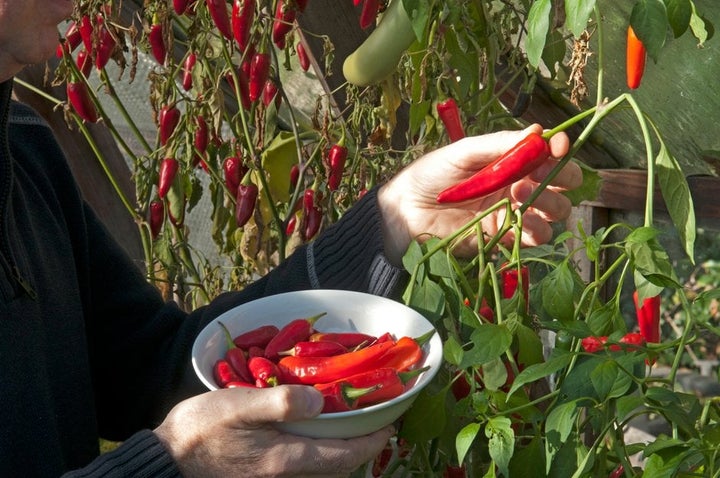
Chillies are generally ready for harvesting from mid-summer into autumn if grown in a greenhouse. Fruiting outdoors should start by August. Towards the end of the season, bring plants indoors if possible, to help the remaining fruits develop.
To maximise your crop, pick chillies when still green, either to use at that stage or to ripen further in the kitchen. Later fruits, produced near the end of the season, can be left to ripen and change colour on the plant. Leaving chillies to ripen on the plant early in the season can be done, for example if you want a richer, hotter flavour, but will deter the production of new flowers, leading to a significantly smaller overall harvest.
Storing
Harvested chillies can be easily dried, frozen or pickled, so you can enjoy your crop through the winter too.
Problem Solving
Chillies usually crop best in a greenhouse – when grown outdoors, fruiting may be reduced, especially in cooler summers. Several -sucking insects can cause problems, particularly when growing indoors, so check plants regularly – see below for details.
Common Problems

Grey mould
Grey mould, caused by the fungus Botrytis cinerea, is a very common disease, causing a soft decay of plant tissues accompanied by a growth of fuzzy gr...

Glasshouse red spider mite
Glasshouse red spider mite is a common sap-feeding mite that can cause mottled leaves and early leaf loss on a wide range of greenhouse and garden pla...







